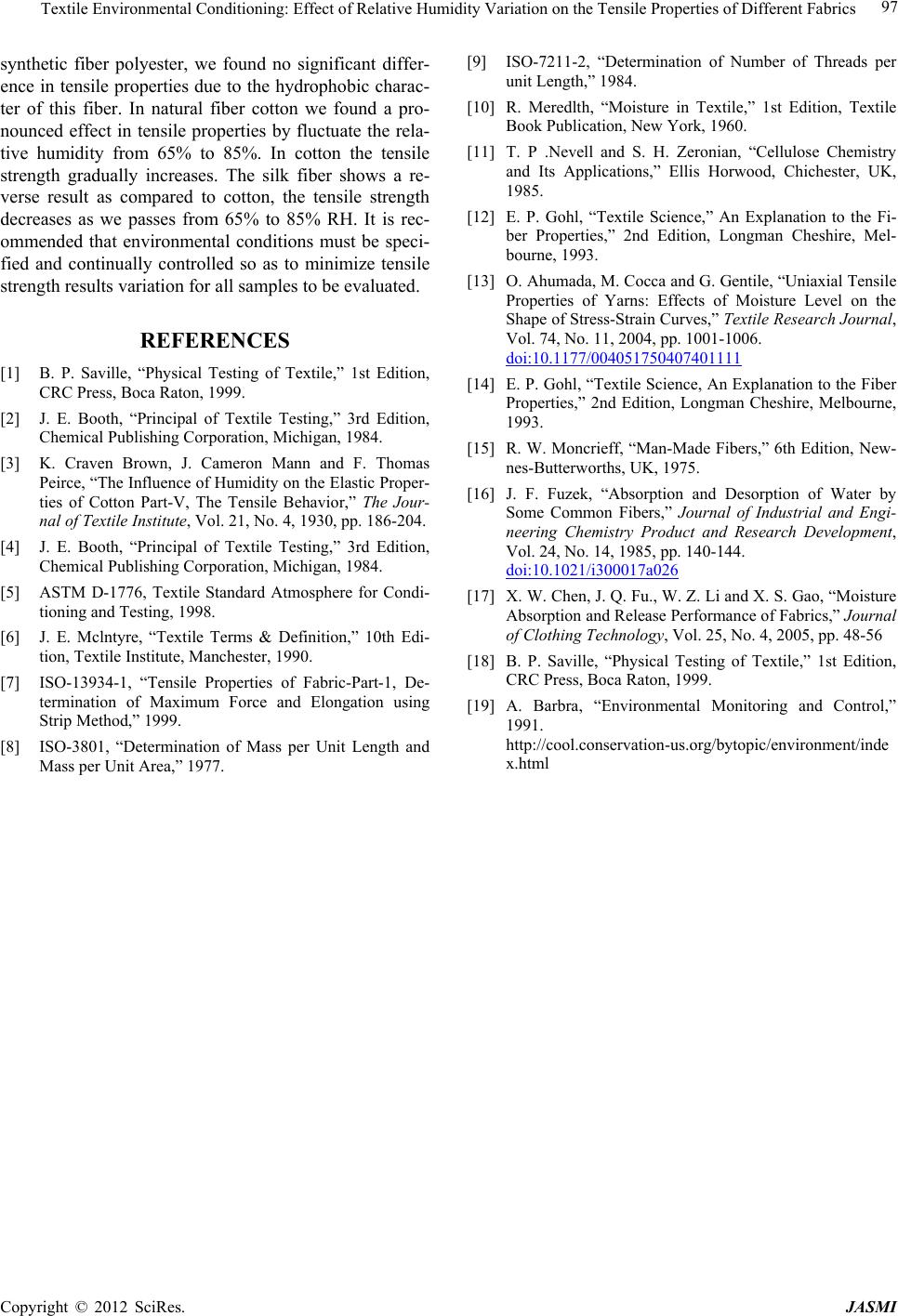
Textile Environmental Conditioning: Effect of Relative Humidity Variation on the Tensile Properties of Different Fabrics
Copyright © 2012 SciRes. JASMI
97
synthetic fiber polyester, we found no significant differ-
ence in tensile properties due to the hydrophobic charac-
ter of this fiber. In natural fiber cotton we found a pro-
nounced effect in tensile properties by fluctuate the rela-
tive humidity from 65% to 85%. In cotton the tensile
strength gradually increases. The silk fiber shows a re-
verse result as compared to cotton, the tensile strength
decreases as we passes from 65% to 85% RH. It is rec-
ommended that environmental conditions must be speci-
fied and continually controlled so as to minimize tensile
strength results variation for all samples to be evaluated.
REFERENCES
[1] B. P. Saville, “Physical Testing of Textile,” 1st Edition,
CRC Press, Boca Raton, 1999.
[2] J. E. Booth, “Principal of Textile Testing,” 3rd Edition,
Chemical Publishing Corporation, Michigan, 1984.
[3] K. Craven Brown, J. Cameron Mann and F. Thomas
Peirce, “The Influence of Humidity on the Elastic Proper-
ties of Cotton Part-V, The Tensile Behavior,” The Jour-
nal of Textile Institute, Vol. 21, No. 4, 1930, pp. 186-204.
[4] J. E. Booth, “Principal of Textile Testing,” 3rd Edition,
Chemical Publishing Corporation, Michigan, 1984.
[5] ASTM D-1776, Textile Standard Atmosphere for Condi-
tioning and Testing, 1998.
[6] J. E. Mclntyre, “Textile Terms & Definition,” 10th Edi-
tion, Textile Institute, Manchester, 1990.
[7] ISO-13934-1, “Tensile Properties of Fabric-Part-1, De-
termination of Maximum Force and Elongation using
Strip Method,” 1999.
[8] ISO-3801, “Determination of Mass per Unit Length and
Mass per Unit Area,” 1977.
[9] ISO-7211-2, “Determination of Number of Threads per
unit Length,” 1984.
[10] R. Meredlth, “Moisture in Textile,” 1st Edition, Textile
Book Publication, New York, 1960.
[11] T. P .Nevell and S. H. Zeronian, “Cellulose Chemistry
and Its Applications,” Ellis Horwood, Chichester, UK,
1985.
[12] E. P. Gohl, “Textile Science,” An Explanation to the Fi-
ber Properties,” 2nd Edition, Longman Cheshire, Mel-
bourne, 1993.
[13] O. Ahumada, M. Cocca and G. Gentile, “Uniaxial Tensile
Properties of Yarns: Effects of Moisture Level on the
Shape of Stress-Strain Curves,” Textile Research Journal,
Vol. 74, No. 11, 2004, pp. 1001-1006.
doi:10.1177/004051750407401111
[14] E. P. Gohl, “Textile Science, An Explanation to the Fiber
Properties,” 2nd Edition, Longman Cheshire, Melbourne,
1993.
[15] R. W. Moncrieff, “Man-Made Fibers,” 6th Edition, New-
nes-Butterworths, UK, 1975.
[16] J. F. Fuzek, “Absorption and Desorption of Water by
Some Common Fibers,” Journal of Industrial and Engi-
neering Chemistry Product and Research Development,
Vol. 24, No. 14, 1985, pp. 140-144.
doi:10.1021/i300017a026
[17] X. W. Chen, J. Q. Fu., W. Z. Li and X. S. Gao, “Moisture
Absorption and Release Performance of Fabrics,” Journal
of Clothing Technology, Vol. 25, No. 4, 2005, pp. 48-56
[18] B. P. Saville, “Physical Testing of Textile,” 1st Edition,
CRC Press, Boca Raton, 1999.
[19] A. Barbra, “Environmental Monitoring and Control,”
1991.
http://cool.conservation-us.org/bytopic/environment/inde
x.html